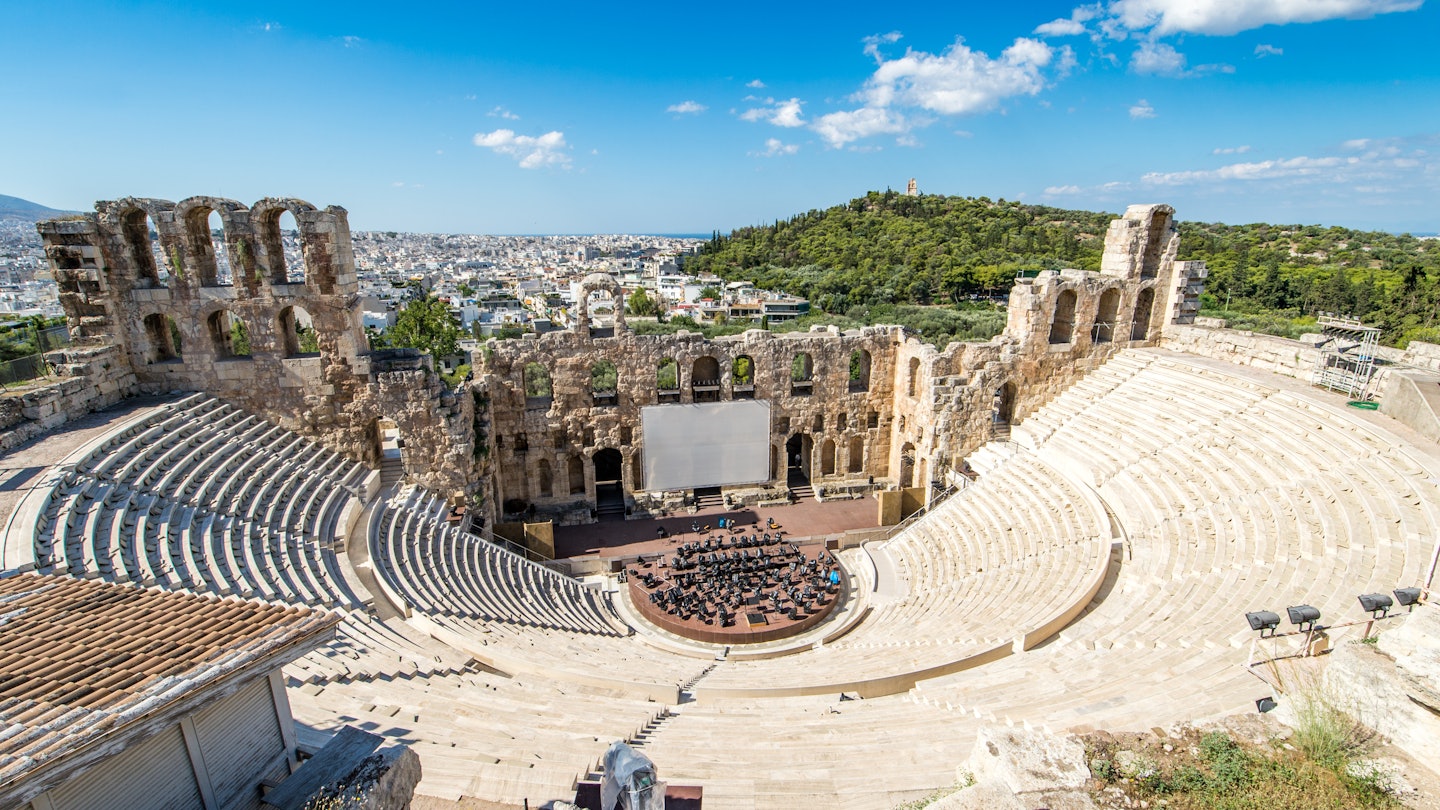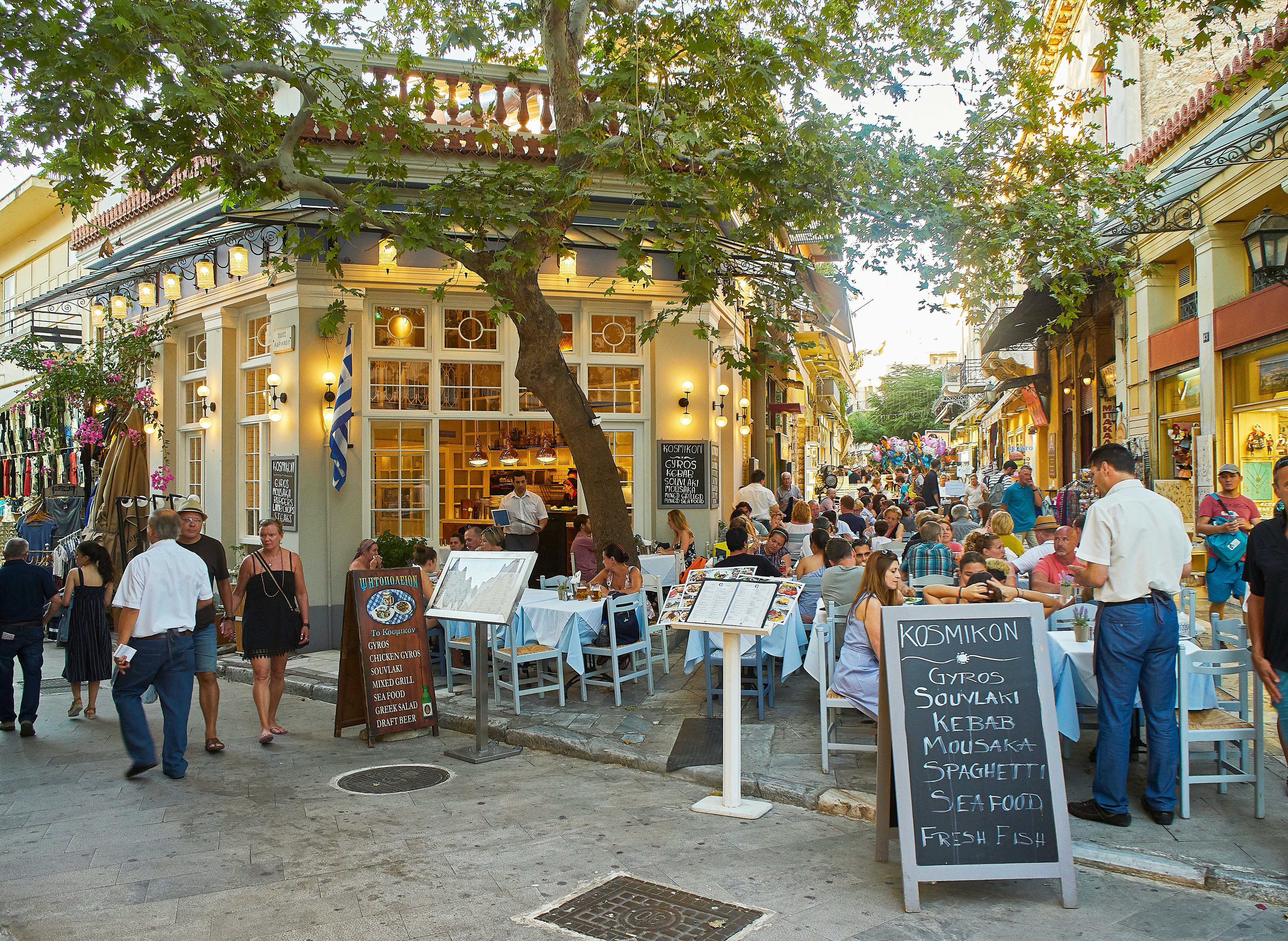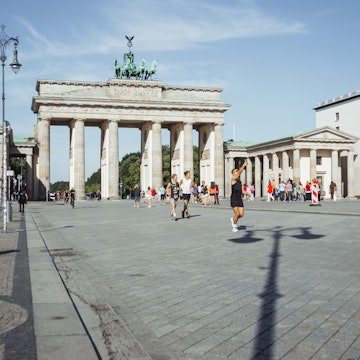

The Odeon of Herodes Atticus in Athens. Getty Images
Founded in 508 BCE, Athens is one of the oldest cities in the world and it's regularly touted as one of the Mediterranean’s best capital cities to visit. From the iconic Parthenon and the street art rivaling that of Berlin to the city's glittering coastline, there’s so much to see and do in this ancient capital.
Whether you’re into architecture, mythology, ancient sites, modern art or simply relaxing by the beach, Athens will keep you occupied. Plan your time, budget and activities with this guide.
When should I go to Athens?
Greece generally attracts most people during the summer months (June to August) and Athens is no different, but we recommend visiting in the spring and autumn to avoid the heat. These shoulder seasons – March to May and September to October – offer lower temperatures and a more comfortable travel experience overall. It’s also worth remembering that Athens can be humid thanks to its coastline, which creates heat in the summer and gives the winter cold an extra chill. Consider this when packing and bring layers for all seasons.
Greek Orthodox Easter usually falls in April or May and the run-up to it, plus the event itself, is a huge celebration on the Greek calendar – even more so than Christmas. Expect street carnivals to mark the end of Lent and street processions to the various neighborhood churches on the Easter weekend, culminating in Mass and a huge meal on the Easter Sunday with a lamb on the spit.
Restaurant prices won’t change much throughout the year, but accommodation prices do vary. The same four-star hotel located near the Acropolis could be €140 per night in March and jump up to €320 in June for a weekend date, with Easter time seeing similar price increases. It’s often cheaper to book directly, and hotels generally publish their prices only about two to three months in advance.

How much time should I spend in Athens?
Many Europeans come to Athens for a weekend break, and long-haul travelers often use the city as as a stopover on the way to the Greek islands.
You can get an initial taste of the city in two days, but we recommend a longer stay to truly understand the essence of this ancient capital. With four days, you can spend a day and a half at famous sights, with an afternoon wandering neighborhoods, and still have time to explore the beaches and ancient ruins of the Athenian coastline for a day or two.
Is it easy to get in and around Athens?
Located at the crossroads between Europe and the Middle East, Greece (and Athens in particular) attracts many tourists, which means the travel infrastructure is well developed and easy to use. Athens International Airport is 33km (21 miles) and a 30- to 45-minute drive – or a 45-minute metro ride – from the city center. There are also good ferry connections to Greece from Italy, with coach or rail services to and from Athens.
Island hoppers will set out from the port of Piraeus, which is 45km (28 miles) from the airport and 10km (6 miles) from the city center. Piraeus is well linked to both the center (20 minutes by metro) and airport (a bus service that takes about 90 minutes).
Public transport around Athens itself is easy, accessible and affordable, with a single ticket valid for a 90-minute journey costing €1.20. There is also a range of ticket deals, including tourist passes for three and five days.
The four modes of transport in Athens are:
the very clean metro system. Note: no food is allowed.
the overground train that connects the center to Piraeus port and other mainland destinations.
an extensive network of buses and electric trolleys. These primarily run to urban neighborhoods beyond the touristic center.
a tram service that connects the city center to the Athens coast and its beaches in about an hour.
After you’ve gotten yourself from the airport to the city center, most of Athens’ popular sights sit within a compact, walkable area. Just be aware of the traffic – cars don’t always immediately stop at red lights, and motorbikes occasionally mount the sidewalk to park.

Top things to do in Athens
Book in advance to visit the Parthenon and the Acropolis
Naturally, many visitors head straight to the Acropolis and the Parthenon, Athens' most notable sights. The Acropolis has a daily visitor’s cap to avoid overcrowding and to preserve the ancient monument, so be sure to book your tickets in advance. It’s not really necessary to have a guide for the Acropolis – which can be booked on site – unless you’re very interested in dates and knowing the intricacies of ancient Greek history.
See ancient treasures at the Acropolis Museum
At the foot of the Acropolis lies the impressive Acropolis Museum, which showcases treasures from the Archaic to Roman periods, plus a stunning glass floor that reveals the excavated ruins underneath it. There’s also a terraced restaurant on the top floor with gorgeous views across to the monument.

Spend a Sunday wandering through the city
Looking for free and low-cost things to do in Athens? Meander along the streets of Monastiraki flea market on a Sunday to peruse all the random wares for sale (everything from old drachma coins to shop mannequins), or take a stroll through the National Garden next to the Parliament building, with its many species of plants and parrots flying freely. Witness the changing of the evzones (presidential guards) every hour on the hour outside the Tomb of the Unknown Soldier, or make your way to Filopappou Hill/Hill of the Muses with its pine forest – a great destination on a hot day thanks to its abundant shade. Be sure to head up here at sunset for views across to the Saronic Gulf.
Look out for ancient treasures across the city
Ancient artifacts crop up all over the city in random places, too; the metro stations of Monastiraki, Akropoli and Syntagma are like mini museums in their own right, and there's even ruins of a Roman tomb in a glassed-off area of the Zara clothing store on Ermou St.
Browse and buy at the best shops in Athens
If it’s shopping you’re into, pedestrianized Ermou St is the place to go. It runs for nearly a mile from the Acropolis area up to Parliament in Syntagma Square, and features tons of fashion brands such as Mac, Desigual and the aforementioned Zara, plus a huge H&M. Greece’s main department store, Attica, is also here, and it's a great place to stock up with your vacation essentials.

My favorite thing to do in Athens
As an aficionado of street art, I love exploring the burgeoning street-art scene here and getting to know the various neighborhoods where it proliferates. Take in the famous Praying Hands Mural just off Omonia Sq, for example, which depicts Jesus praying for the people down on Earth – a play on Albrecht Dürer’s drawing Praying Hands (1508).
I also love wandering around the hidden village of Anafiotika, which sits beneath the northeast side of the Acropolis. A sub-district of Plaka, it was built in the mid-1800s when King Otto brought in workers from the Greek island of Anafi to construct his palace. Homesick, the workers set about making their neighborhood a replica of their homeland, building white, sugar-cubed houses with flat stone roofs and brightly painted wooden doors and shutters, like those found in the Cyclades. Pink and white bougainvilleas wind their way up these buildings, several of which have roof gardens.
Anafiotika is a bit difficult to find, but worth the effort. Start at the Acropolis main entrance, and walk to your left along the path; keep the monument to your right until you reach the Church of Metamorphosis. Continue straight past the church and follow the wider path up a steep hill. The path turns right and runs into stairs – this is the start of the island village.

How much money do I need for Athens?
Athens isn’t an expensive place to visit compared to other European destinations, especially outside the summer season when prices rise significantly.
Hostel dorm room: from €26 per night
Basic room for two: €36–128 depending of style of hotel and location
Self-catering apartment: €65 per day
Public transport ticket: €1.20 for a 90-minute journey, €10 from the airport, €4.10 for a day pass, €20 for a three-day pass including return airport journeys.
Coffee: €3
Typical Greek gyros with salad and fries: €3–4
Dinner for two: from €30 without alcohol
Beer at a pub: from €3
What should I pack?
Bring layers, no matter the season. Because Athens is a coastal city, it’s sticky in the summer and quite chilly in the spring, fall and winter evenings. Layers are always a good idea: think T-shirts, light sweaters and a jacket for the cooler months. For the really hot summer months, bring a sports cooling towel to wrap around your neck to cool off as you explore.
Is Athens a safe city?
Be aware of your belongings on the metro. As with any capital or big city, pickpockets can take advantage of large tourist crowds, especially on crowded public transport. Avoid hanging large cameras around your neck and keep your backpack in front of you. You may also want to invest in a hanging cord for your cell phone to loop across your body so it can’t be snatched from your hands.
I heard you can't flush toilet paper. Why not?
The plumbing in Athens is antiquated and the pipes tend to be very narrow. Flushing paper down the toilet will clog things up, so you’ll always find a bin with bag inside it in the bathroom for you to place toilet paper inside. This is removed daily by housekeeping.
















